3.4: Russian Multiculturalism and Tension
- Page ID
- 131880
During the period of Russia’s expansion and development as an empire, and later during the time of the Soviet Union, Russia’s territory included not only ethnic Russians but other surrounding groups as well. Ethnicity is a key feature of cultural identity and refers to the identification of a group of people with a common language, ancestry, or cultural history. Many of these minority ethnic groups harbored resentment over being controlled by an imperial power.
Prior to the Bolshevik Revolution, the Russian Empire’s response to the non-Russian communities they controlled was known as Russification, where non-Russian groups give up their ethnic and linguistic identity and adopt the Russian culture and language. This type of policy is known as cultural assimilation, where one cultural group adopts the language and customs of another group. The Russian language was taught in schools and minority languages were banned in public places. Catholic schools were banned and instead, Russian Orthodoxy, part of the Eastern Orthodox Church, was taught at state-run schools. The Russian Empire essentially sought to make everyone in the territory Russian. This policy was only marginally successful, however, and was especially difficult to implement in the outer regions.
Under the Soviet Union, the policy of cultural assimilation had less to do with becoming Russian and more to do with being part of the Soviet Union, what could be thought of as Sovietization. The Soviet government organized the country as a federation, where territories within the country had varying degrees of autonomy (Figure \(\PageIndex{1}\)). The larger ethnic groups formed the Soviet Socialist Republics, or SSRs. For example, the Uzbek SSR largely contained members of the Uzbek ethnic group. The Kazakh SSR similarly consisted mostly of people who were ethnically Kazakh. These SSRs did not represent all of the ethnic diversity present in Russia nor did they provide these territories with autonomy.
You might recognize the names of these republics as they gradually became independent states after the collapse of the Soviet Union. The Turkmen SSR became Turkmenistan, for example. Many of these areas, particularly in Central Asia, are majority Muslim and thus adopted the Persian suffix “-stan” meaning “place of” or “country” after independence.
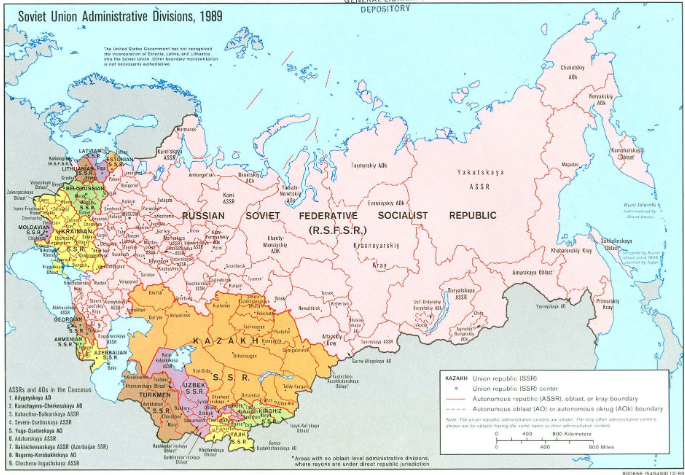
Under Soviet Rule, some policies of Russification expanded. In Muslim areas of Central Asia and the Caucasus, the use of the Arabic alphabet, the language of the Qur’an, was abolished. The government also sent many Russians into majority non-Russian areas to further unify the country. Other ethnic groups, particularly those perceived as troublemakers by the government, were deported from their ancestral homelands and resettled elsewhere.
The ethnic map of the former Soviet Union today, in part, reflects this multicultural history and the legacy of resettlement policies (Figure \(\PageIndex{2}\)). Over 3 million people were deported to Siberia between 1941 and 1949, a large portion of whom died from disease or malnutrition. Others were deported from the Baltic area or from the area near the Black Sea. Overall, around 6 million people were internally displaced as a result of the Soviet Union’s resettlement policies and between 1 and 1.5 million of them died as a result.
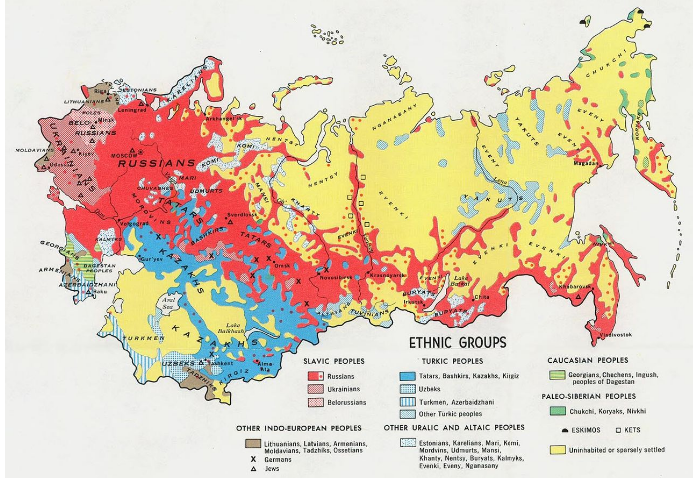
Although Russia today is comprised mostly of people who speak Russian and identify with the Russian ethnicity, it contains 185 different ethnic groups speaking over 100 different languages. The largest minority groups in Russia are the Tatars, representing around 4 percent of the population with over 5 million people, and Ukrainians at around 1.4 percent or almost 2 million people. Other ethnic groups, like the Votes near Saint Petersburg, have only a few dozen members remaining. Because of the Soviet resettlement policies, the former Soviet republics have sizable Russian minorities. Kazakhstan and Latvia, for example, are almost one-quarter Russian. This has often led to tension within Russia as minority groups have sought independence and outside of Russia as ethnic groups have clashed over leadership.
In Ukraine, the tension between the Ukrainian population and Russian minority has remained high and represents a broader tension between the Eastern European regions that are more closely aligned with Russia and those that seek greater connectivity and trade with Western Europe. Eastern Ukraine is largely comprised of Russian speakers, while Western Ukraine predominantly speaks the state language of Ukrainian (Figure \(\PageIndex{3}\)). Overall, around three-quarters of people in Ukraine identify with the Ukrainian ethnicity.
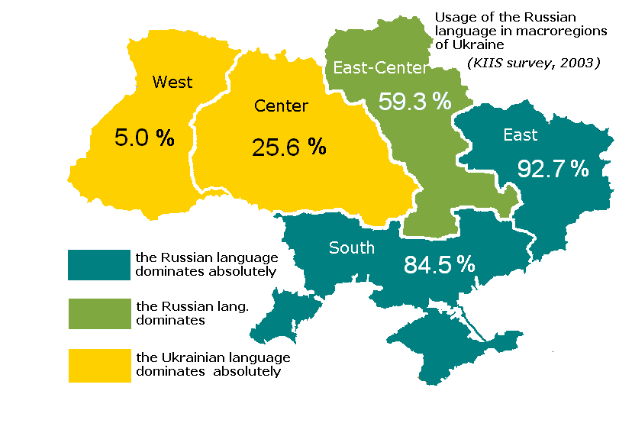
In 2014, the tension between the two groups escalated as then-president Victor Yanukovych backed away from a deal to increase connections with the European Union and instead sought closer ties with Russia. In Western Ukraine, people engaged in widespread protests prompting the government to sign a set of anti-protest laws, while in Eastern Ukraine, most supported the government. Ultimately, Yanukovych was removed from office prompting military intervention from Russia.
Specifically, Russia sought control of Crimea, an area that had been annexed by the Russian Empire and was an Autonomous Soviet Socialist Republic until the 1950s when it was transferred to Ukraine. After the 2014 protests, a majority of the people of Crimea supported joining Russia and it was formally annexed by Russian forces. The region is now controlled by Russia (Figure \(\PageIndex{4}\)). The international community, however, has largely not recognized Crimea’s sovereignty or Russia’s annexation.
Russia invaded Ukraine on February 24, 2022. Internationally considered an act of aggression, the invasion triggered Europe's largest refugee crisis since World War II, with more than four million Ukrainians leaving the country and a quarter of the population displaced (as of the end of March).
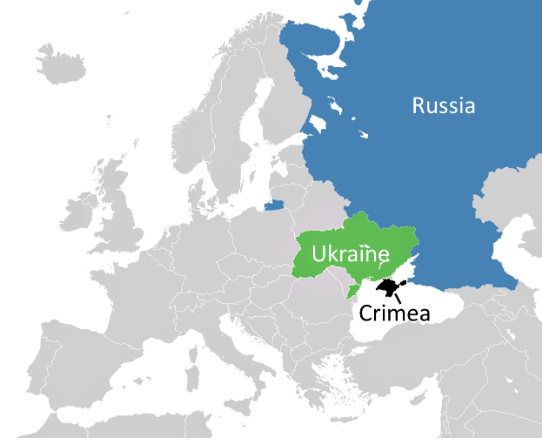
Figure \(\PageIndex{4}\): Map of Crimea (Derivative work from original by Crosswords, Wikimedia
Commons)
Several other ethnic groups that remain in Russia desire independence, particularly in the outskirts of the country in the Caucasus region along Russia’s border with Georgia and Armenia (Figure \(\PageIndex{5}\)). Chechnya is largely comprised of Chechens, a distinct Sunni Muslim nation. The territory opposed Russian conquest of the region in the 19th century but was forcefully incorporated into the Soviet Union in the early 20th century. 400,000 Chechens were deported by Stalin in the 1940s and more than 100,000 died. Although Chechnya sought independence from Russia, sometimes through violent opposition, it has remained under Russian control following the collapse of the Soviet Union. Dagestan has been the site of several Islamic insurgencies seeking separation from Russia. Ossetia remains divided between a northern portion controlled by Russia and a southern region controlled by Georgia.
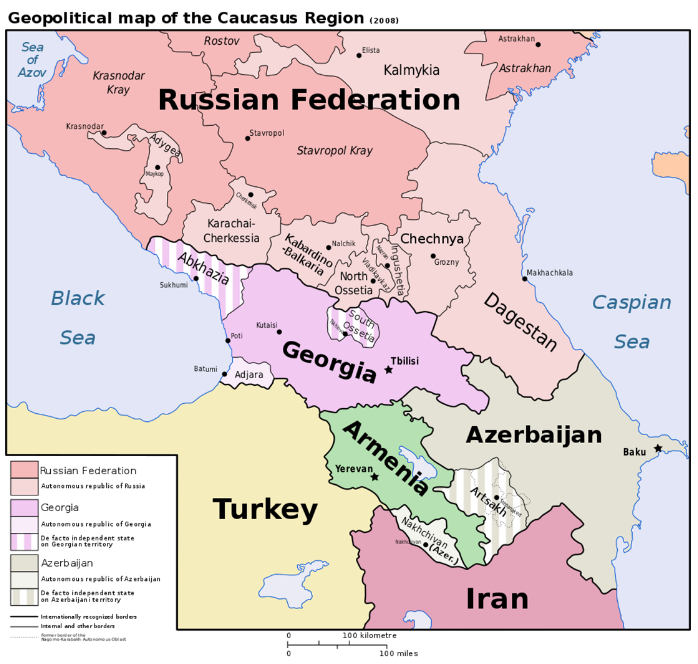
In an area as large and as ethnically diverse as Russia, controlling the territory in a way that is acceptable to all of its residents has proven difficult. In many large countries, the farther away you get from the capital area and large cities, the more cultural differences you find. Some governments have embraced this cultural difference, creating autonomous regions that function largely independently though remain part of the larger state. Stalin and Russia’s tsars before him tried to unify the country through the suppression of ethnic difference, but ethnic and linguistic identities are difficult to obliterate.
- Ethnicity:
-
the identification of a group of people with a common language, ancestry, or cultural history
- Russification:
-
a system of cultural assimilation in Russia where non-Russian groups give up their ethnic and linguistic identity and adopt the Russian culture and language
- Assimilation:
-
when one cultural group adopts the language and customs of another group
- Eastern Orthodox Church:
-
a branch of Christianity that split from Roman Catholicism in 1054 CE and includes a number of different denominations such as the Russian Orthodox and Greek Orthodox churches

